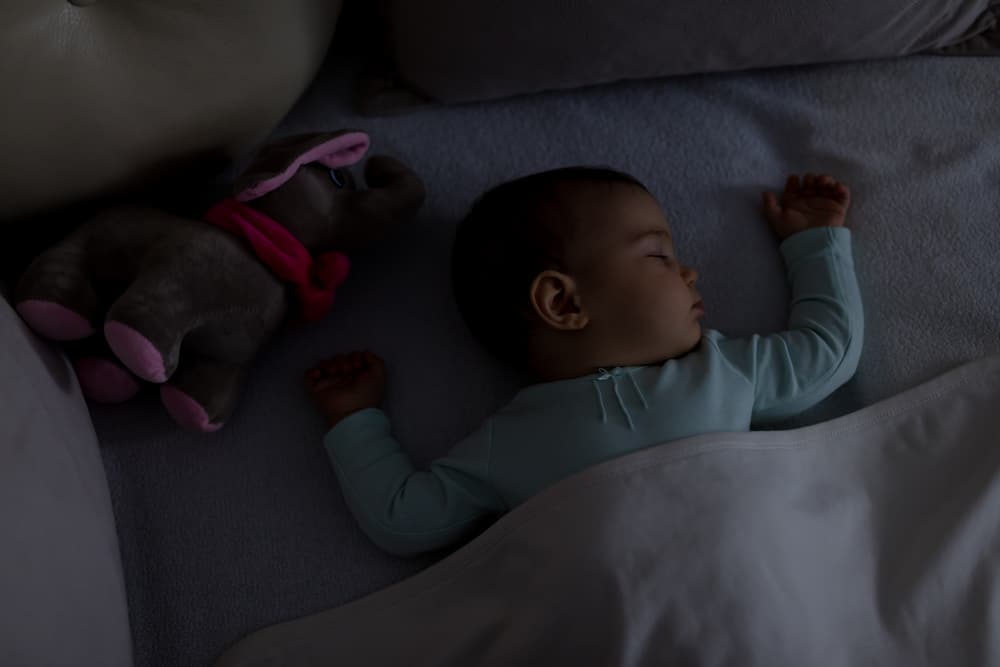Every parent in the world swears by at least one baby sleep training method. Because at one point or another, every new parent tries one. And here’s why.
Taking care of a baby can be relentless. The moment you brought your newborn home is probably etched in your memory for two reasons – you realized you were fully responsible for another human being, and it was the last time you felt rested… like, sleep-as-much-as-you-need rested.
Because the moment your newborn came into your life, your carefully planned day-to-day schedule turned into a chaotic mess where crying was considered communication and sleep was more precious than gold.
You told yourself you could handle it, and you did for a while. But after a few weeks of sleeping in short bursts, your eyes started drooping and you could barely pay attention to what you were doing. You moved like an extra from The Walking Dead, and frankly, you probably looked and smelled like one too.
Nowadays, you celebrate each half-hour of shut-eye, and you fondly remember catching three hours of uninterrupted sleep the other day. That was a good one.
The solution is clear – you need more sleep. And not the fretful sleep you get between your baby’s crying sessions. No, you need to sleep for a few hours at a time each night. But to do that, you have to convince your baby to rest quietly for a few hours.
So, how can you train your baby to sleep? Read on to find out.
Sleep Training 101
What Is Baby Sleep Training?
Sleep training means teaching your infant to fall asleep without your help. If you successfully train your baby to sleep, you get to put them down for bed when they are fully awake and watch them drift off without rocking, cuddling, or nursing them. Sounds great, right?
And it gets better. One very important aspect of sleep training that’s often overlooked is that it also helps your baby fall back to sleep when they inevitably wake up overnight. And yes, your baby will still get up at night, even if you train them to sleep.
Because here’s the thing, night waking is part of the human sleep cycle, so it’s totally normal for babies to wake up at random times in the night. You do that as well, but your adult brain already knows how to sleep and you fall back asleep in seconds. On the other hand, your baby cries for you when they wake up because they don’t know how to fall back asleep on their own.
Does My Baby Need Sleep Training?
You might be wondering whether your baby needs sleep training or if they’re going to develop their own habits as they get older. You should consider sleep training if you notice that your child is cranky and overtired, even if they might eventually develop their own sleep habits.
Here’s the thing, healthy sleep is important for both of you. And if your baby isn’t resting well, chances are you aren’t either. Sleep deprivation in infants has been linked to obesity and slower growth, while parents who are sleep deprived are more likely to suffer from postpartum anxiety.
Teaching your baby healthy sleep habits and training them to sleep can keep both of you well-rested and in top shape.
Is the Cry-It-Out Method the Only Way to Sleep Train Your Baby?
Sleep training is not the same as the “Cry-It-Out” method (which we explore more later on in this article) unless you want it to be. Sure, training your baby to sleep might (and probably will) involve some crying, especially when you and your baby are just starting out. But you don’t have to use the “Cry-It-Out” method unless you want to.
There are many baby sleep training methods out there, and the truth is that not all of them will work for you and your infant. You can try out different methods until you find one that convinces your baby to sleep without your help.
Does Sleep Training Involve Weaning?
Sleep training does not necessarily involve weaning. You can still feed your baby during the night. You should consult your pediatrician to find out when you should stop your baby’s nighttime feeds.
When Should I Start Sleep Training My Baby?
There’s no simple answer to this question. Even though most sleep experts agree that you can start “formal” sleep training when your baby is 4-6 months old, you can start teaching your baby some healthy sleep habits from day 1.
However, you should only start “formal” sleep training if you believe you and your baby are ready for it. Because you need to be ready as well. Sleep training can be a huge undertaking, so the parents have to fully commit to it.
You should ask yourself the following questions before even considering sleep training your baby:
- What is your schedule going to look like for the following 2-4 weeks? Are there any events or trips that might interrupt your training?
- Are you ready to commit to following a pre-planned schedule for 2-4 weeks?
- Are you ready to make the lifestyle changes necessary to train your baby to sleep?
- Did you discuss sleep training with your partner and agree on a method that would work for both of you? Did you consult with the other members of your household?
- Did you figure out which baby sleep training method you’re going to try? Do you have a backup method, just in case?
Once you’ve decided that you are ready to begin sleep training, it’s time to find out if your baby is ready as well. The first thing you should do before starting a sleep training regimen is consulting with your pediatrician to rule out health or medical factors that might affect your child’s sleep.
Next, it’s time to take your baby’s age into consideration. While most babies are ready to start their sleep training when they’re 4 or 5 months old, your child can learn some healthy sleep habits and routines starting from day 1.
Even though they might not seem very important on their own, learning your baby’s sleep cues, establishing bedtime routines, and creating calm environments for your baby to sleep in lay the foundation for sleep training. You can teach your baby these techniques to help them fall asleep faster and begin the “formal” sleep training when they reach the right age.
How to Prepare for Sleep Training

You can prepare yourself and your baby for sleep training in a number of ways.
Do Your Research
You’re already reading about baby sleep training, which is great. But you should also consider talking to your pediatrician or a sleep expert about it.
Establish Sleep Routines
Following a regular sleep schedule and putting your child to bed at a consistent time each evening can prime your baby for sleep. Setting up a soothing routine like a feed and a bath followed by stories or songs and pajamas can also help by calming your child and preparing them for sleep. You could also try swaddling or rocking your baby before sleep. Each family has its own pre-bedtime ritual, so make sure you develop yours.
Keep Your Baby Active
Make sure that your baby has been awake and active for an appropriate amount of time before putting them to bed. Fill their daytime awake periods with stimulating activities so they’ll be tired in the evenings. An under- or over-tired baby will have trouble falling asleep.
Create a Good Sleeping Environment
Could you fall asleep while someone is watching “The Bachelor” on high volume with all the lights turned on? Probably not, right? Well, those things make it difficult for your baby to fall asleep as well. Make sure that the environment your baby is going to sleep in is dark, quiet, and slightly cool. Some babies respond well to white noise, so you could try that as well.
Best Baby Sleep Training Methods
1. The Chair Method)
The chair method is one of the gentlest baby sleep training methods. This method is ideal for babies older than five months and it should be easy on you and your baby.
This method has multiple variations, but most of them follow the same basic steps:
- Prime your baby for sleep – Go through your nighttime rituals and make sure that your baby is drowsy and ready for sleep.
- Sit in a chair next to the crib – Put your baby in their crib and sit in a chair next to them until they fall asleep. You can leave the room once they’re asleep. Do not pick up your baby if they cry while you’re sitting next to them.
- Return to the room when necessary – Return to the room if your baby wakes up and cries, but do not pick them up. Sit in the chair and wait until they fall back asleep.
- Move the chair – Move the chair farther from the crib once every few nights (once every 3 – 5 nights should work, but every baby is different).
- Move the chair out of the room – Once you’ve distanced yourself from the crib, you can take the chair out of the room. Your baby should know how to soothe themselves by now and shouldn’t need your presence to fall asleep.
Even though the chair method is a popular one, some parents report that it can backfire at times. Some babies might be startled when they wake up and realize that they’re all alone, which can lead to tears and sleepless nights.
Other parents say that this method is especially difficult because it recommends not picking your baby up when they cry, so your baby sees that you’re in the room seeing them cry and not responding, which can be painful to endure.
2. The Pick Up, Put Down Method
The pick up, put down method is ideal for babies younger than seven months. It’s considered a gentle sleep training method by some; however, some say that babies might find this method confusing.
This method involves you watching the baby fall asleep without you having to do much to help them.
After you’ve completed your baby’s sleep routine and it’s time to put them to bed, you simply lay them down in their crib. Your baby should be drowsy and relaxed from their bedtime routine, so they should be awake but not too active at this point.
If your baby doesn’t cry or fuss, the original method recommends sitting quietly in the room until they fall asleep. Some variations of this method recommend leaving the room when your child is calm.
This method recommends using the “stop, wait, and listen” approach. Instead of rushing in to pick your baby up when they start crying, you should wait for a few seconds to determine whether they’re simply fussing or they’re really worked up and need comforting.
Pick up your baby if they don’t settle down on their own. Hold and cuddle them to calm them down.
You can lay your baby down again once they settle down but are still awake and restart the process.
This method recommends repeating this process until your baby falls asleep. However, some infants might take a long time to fall asleep this way, which means that this method might put your patience to the test. Even though this method can be frustrating, it’s very important to be calm and quiet when comforting your baby.

3. The Ferber Sleep Training (Check and Console Method or Graduated Extinction)
The Ferber sleep training method, also known as the check and console method or graduated extinction, is considered a less gentle method of sleep training, but it’s very popular because it works for a lot of babies.
This method teaches babies to self-soothe and fall asleep without any parental intervention. One of the benefits of this method is that it teaches your child to soothe themselves and fall back to sleep when they wake up during the night.
Even though there are multiple variations of this method, all of them use the same basic principles:
- Nighttime routine – You should go through your nighttime routine before putting your baby in their crib. Your child should be awake but drowsy.
- Leave the room – You should leave the room after putting your baby in the crib.
- Wait for a specific amount of time – Wait for a specific amount of time (say a minute, two, or five) before going back in to reassure your baby with soothing words like “I love you” or a soothing touch like a pat or a rub. You should do this no matter if the baby is crying or not. Make sure you don’t enter the room sooner than you should, even if your baby cries.
- Leave the baby alone/Pick the baby up – This is where most variants of the Ferber sleep training differ. Some variants recommend not picking up your baby if they cry. The logic behind this is that your presence alone should convince the infant that you haven’t abandoned them, which is why they should stop crying. Other variants recommend picking up the baby and soothing them until they stop crying and putting back in the crib so they can fall asleep on their own.
- Lengthen the amount of time you spend outside the room – Gradually increase the amount of time you spend outside the room over several nights. Continue this process until you only have to check on your baby once or twice per night. It might be helpful to keep a record of the amount of time you spent outside the room each night to keep track of your progress.
- Do not return – The final step of the Ferber method is putting your baby in their crib, leaving the room, and not returning until morning. Your baby should have learned to soothe themselves until this point, so they should be able to sleep through the night with no parental intervention.
Some parents consider the Ferber method just as bad as the “Cry-It-Out” method. However, many parents say that the Ferber method is superior because you can check on the child and soothe them overnight.
Even though some parents might be against it, the Ferber sleep training doesn’t seem to produce any long-term psychological effects. And the best part is, most parents get to see some improvements in as little as one week.
Love it or hate it, one thing’s for certain. The Ferber method gets the job done.
4. The Cry It Out Method
The “Cry-It-Out” method, also known as the extinction method, is the most popular way of training your baby to sleep. Many parents believe that the “Cry-It-Out” method is cruel, but studies show that this method has no long-lasting positive or negative effects on the child.
To use this method, you simply have to go through your nighttime routine. Once the baby is drowsy, put them in their crib and walk away.
Now, some experts recommend coming back to the room for a feed while others recommend leaving your baby alone until morning. This totally depends on your baby’s age and nutritional needs.
This method is considered less gentle for a reason. Your baby will take it particularly hard the first night. Some babies might wake up crying every hour or so. Some might cry for an hour. Every child will react differently to their new situation, but none will like it, so you should prepare yourself for this emotional burden.
Even if the “Cry-It-Out” method is viewed negatively nowadays, many people around the world still use it because it works. You might train your baby to sleep through the night in as little as three days if you use it. However, you should try the extinction method for an entire week before determining whether it worked or not.
Current studies show that parents can confidently use the “Cry-It-Out” method to reduce the short- and medium-term burden of infant sleep problems that might lead to maternal depression.
How Do I Choose the Best Sleep Training Method for My Baby?
You can try out multiple sleep training techniques to find out what works best for you and your baby. There is no “best overall solution” here. At the end of the day, you’re the one who knows what’s best for you and your child.
However, you should keep in mind that you and your partner might have different views on what’s acceptable and unacceptable to try with your child. As a rule of thumb, it would be better to start with a gentle method and progress to less gentle ones only if the previous ones are not successful.
Ultimately, the best sleep training method for you and your family will be one you can alter to meet your needs and expectations.
How Long Does Baby Sleep Training Take?
Training your baby to sleep can be done in as little as three days using the “Cry-It-Out” method, or two weeks or more using the chair method.
Keep in mind that every baby is different, so your training results will differ as well. Some parents might train their firstborn to sleep in a week using a certain technique and be totally unsuccessful when trying the same process with their second child.
Some babies will be completely unresponsive to certain sleep training methods, but that’s normal. However, you should try your selected method for at least a week before giving up on it.

Consistency Is Key
You have to be consistent if you want to train your baby to sleep. Trying a certain sleep training technique for two nights in a row and switching to another one the third night will only confuse and upset your baby.
Make sure you and your baby are ready for sleep training before starting it, consult with your pediatrician, and go all-in on the process. Nobody enjoys hearing their infant cry, but the outcome is sometimes better than the process and this is one of those cases.
Sleep Training Is Beneficial for Your Family
Some people advocate leaving your child to sleep train themselves. They sometimes go as far as calling parents who sleep train selfish or downright abusive. But multiple scientific studies have shown that training your baby to sleep has no lasting negative effects on the baby’s health and wellbeing.
However, the same studies show that baby sleep training can have an overall positive effect on the health and wellbeing of the parents. Waking up several times per night can lead to depression-like symptoms and attention problems. In addition, sleep deprivation can sometimes lead to marital problems in new parents.
Given the scientific evidence, the idea that parents who sleep train their babies are selfish couldn’t be further from the truth. In fact, by encouraging your baby to sleep and by sleeping more yourself, you might actually improve your family’s wellbeing.
